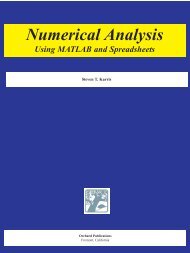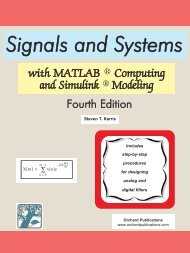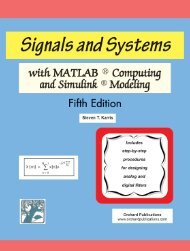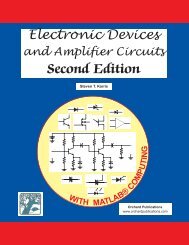Electronic Devices and Amplifier Circuits
Electronic Devices and Amplifier Circuits - Orchard Publications
Electronic Devices and Amplifier Circuits - Orchard Publications
Create successful ePaper yourself
Turn your PDF publications into a flip-book with our unique Google optimized e-Paper software.
Substitution, Reduction, <strong>and</strong> Miller’s TheoremsF.3 Miller’s TheoremMiller’s theorem states that under certain conditions, to be established below, the networks of FiguresF.15(a) <strong>and</strong> F.15(b) are equivalent.iii1 i 122ABA Y Bv v1Yv 2 = Kv 1 1 Y 2v 2 = Kv 11( a) ( b)Figure F.15. Illustration for Miller’s theoremIn the networks of Figure F.15, the constant K denotes the voltage gain from Node A to Node B,that is,K = v 2 ⁄ v 1(F.6)orv 2 = Kv 1(F.7)At NodeAof Figure F.15(a), we observe thati 1 = Yv ( A – v B ) = Yv ( 1 – v 2 ) = Yv ( 1 – Kv 1 ) = Yv 1 ( 1 – K)(F.8)<strong>and</strong> at Node Aof Figure F.15(b), we obtain,i 1 = Y 1 v 1(F.9)For equivalence, relations (F.8) <strong>and</strong> (F.9) must be equal. Thus,Y 1 = Y1 ( – K)(F.10)At NodeBof Figure F.15(a), we observe thati 2 = – i 1 = – Y( v 1 – v 2 ) = Yv ( 2 – v 1 ) = Yv ( 2 – v 2 ⁄ K) = Yv 2 ( 1–1 ⁄ K)(F.11)<strong>and</strong> at Node Bof Figure F.15(b), we obtain,i 2 = Y 2 v 2(F.12)For equivalence, relations (F.11) <strong>and</strong> (F.12) must be equal. Thus,Y 2 = Y1 ( – 1⁄K)(F.13)We should remember that for the equivalent circuit of Figure F.15(b) the value of the gain K , onceestablished, it cannot be changed. Thus, while Miller’s theorem can be applied to find the inputimpedance, it should not be used to determine the output impedance of an amplifier since whenF−10<strong>Electronic</strong> <strong>Devices</strong> <strong>and</strong> <strong>Amplifier</strong> <strong>Circuits</strong> with MATLAB® / Simulink® / Sim<strong>Electronic</strong>s® Examples, Third EditionCopyright © Orchard Publications







